Understanding Force Wind Dynamics in Surfing
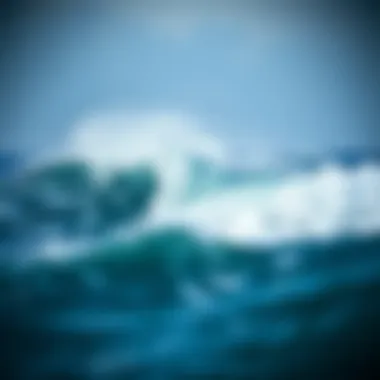
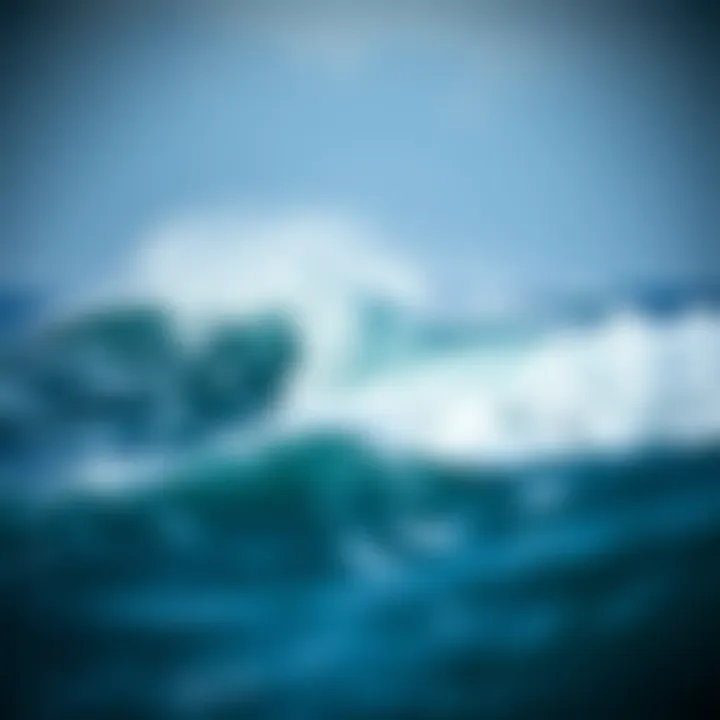
Intro
Surfing is more than just a sport; it’s a lifestyle and a connection to nature. The relationship between the surfer and the ocean is intricate, and one major player in this dynamic is wind. Force wind significantly impacts surf conditions, shaping how waves break and the overall experience on the water. Surfing enthusiasts often overlook this factor, yet understanding wind dynamics can enhance performance and enjoyment. This guide aims to shed light on how wind influences wave formation and surfboard handling, providing valuable insights for surfers seeking to align their skills with environmental elements.
Surfing Techniques
Mastering the Basics
As a budding surfer, getting the hang of fundamentals is crucial. Far too many surfers jump the gun, rushing to catch waves without grasping how wind affects their ride. Wind direction, for instance, plays a critical role. When offshore winds blow, they groom the wave, creating clean, well-formed faces. This setup allows for more control and a smoother ride. Surfers can practice paddling into waves during such conditions to fine-tune their technique.
Aside from just wind direction, understanding wind speed is equally important. Choppy and chaotic waves caused by strong onshore winds can make paddling ineffective. This calls for different tactics. You may have to wait for more favorable conditions or adjust your surfing position at the peak of the wave. Each season brings different wind patterns, and being aware of these allows surfers to adapt their approach and maximize their potential.
Advanced Maneuvers
Once you've got the basics down, it’s time to elevate your skills. Tactics like reading the wave pattern in relation to wind orientation can make or break your performance. For instance, when side-offshore winds blow, they push waves toward the shore, leading to faster and steeper takeoffs. Surfers can harness this setup to perform tricks like cutbacks or aerials.
Furthermore, wind also affects the surfboard's maneuverability. The right board can enhance how you slice through the water. A shorter board might work well in choppy conditions, while a longer board can provide stability in more favorable winds. Understanding how to use your equipment in various wind situations ultimately opens doors to more advanced techniques.
Surfing Lifestyle
Sustainable Surfing Practices
As environmentalists are becoming increasingly aware of how human activities impact oceans, sustainability in surfing is more important than ever. Surfers can adopt eco-friendly practices by choosing sustainable boards or participating in beach clean-ups, helping cultivate a culture of respect for the natural resources we treasure. When wind patterns shift due to climate change, waves can alter as well, meaning a commitment to sustainability not only preserves our sport but also the environment.
Surf Culture Around the World
Surfing isn't just limited to one region or style; it’s a vibrant culture spread across the globe. From the laid-back beaches of California to the powerful waves of Hawaii, each locale has its unique take on surf. Coastal traditions often blend local customs, shaping how surfers interact with the ocean.
Local surfers often adapt their skills and techniques based on the predominant wind patterns in their area. For instance, in Indonesia, surfers have to adjust to the trade winds that create powerful swell seasons. Understanding these nuances can enhance a traveler’s experience and connect them deeper with the local surf community.
"As surf culture continues to evolve, embracing the wind's role in shaping our waves is essential to our journey as surfers."
Surfers who take the time to comprehend their environment often find themselves more attuned to the waves, leading to a richer experience. Delving deep into the dynamics of force wind not only optimizes performance but also cultivates appreciation for the sport as a whole.
Useful Resources
- Wikipedia on Surfing
- Britannica's Take on the Science of Waves
- Reddit Surfing Community
- NOAA - Environmental Impacts on Surf Conditions
Each aspect of surfing, from techniques to lifestyle practices, intertwines with environmental factors like wind. By understanding and respecting these dynamics, surfers can enhance both their skills and their connection to the ocean.
Understanding Force Wind
Understanding Force Wind is pivotal in grasping how surfing operates within its natural environment. Wind isn't just a background player; it functions as a fundamental force that greatly impacts wave formation, surf conditions, and thereby, the overall surfing experience. For surfers, being cognizant of wind dynamics can mean the difference between riding a perfect wave or being left floundering in less than ideal conditions.
The forces of wind contribute to a range of factors from wave height to shape, making comprehension of these elements critical for both novice and seasoned surfers alike. In particular, recognizing how wind interacts with waves can refine a surfer's approach to their sport, influencing technique, timing, and equipment choice. Furthermore, with an ongoing focus on environmental standards and sustainability, there’s a growing need for surfers to appreciate the delicate balance between their activities and nature.
Understanding these wind dynamics also opens pathways to better performance outcomes. Surfers can develop strategies to adapt their surfing style based on wind speed and direction. For instance, practicing in varied wind conditions can enhance skill levels, and allow for a greater connection with the ocean's behavior. Thus, this section will delve deeper into the nature of force wind, its definitions, and its significance for surfers in today’s world.
Defining Force Wind
Force wind can be defined as the kinetic energy generated by moving air, which is sensed as wind on the surface of the earth. This energy is influenced by various factors, including temperature, pressure gradients, and geographical features. All of these elements can transform how wind flows over oceans and coastlines, contributing to its behavior in coastal zones.
In surfing contexts, we can categorize wind into two main types: offshore wind and onshore wind. Offshore wind blows toward the sea from the land, often creating clean and well-formed waves that are ideal for surfing. Meanwhile, onshore winds carry air from the ocean to the shore, sometimes resulting in choppy, disrupted waves that might not be as enjoyable to ride.
The Importance of Wind in Surfing
Wind plays several crucial roles that can influence a surfer's experience:
- Wave Formation: Wind generates waves through the friction between air and water. The speed and direction of the wind directly affect the size and quality of these waves.
- Performance Optimization: Knowledge of wind patterns assists surfers in selecting surf spots and times for ideal wave conditions. Surfers familiar with local wind patterns can maximize their time in the water and catch better waves more frequently.
- Environmental Awareness: As surfers become increasingly aware of climate change and its impact on our oceans, understanding how wind patterns change with climate shifts helps to foster responsible surf practices. This awareness encourages surfers to adopt sustainable behaviors and advocate for marine conservation efforts.
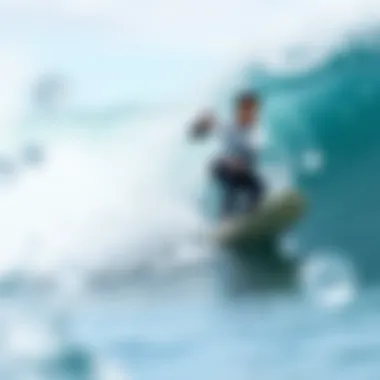
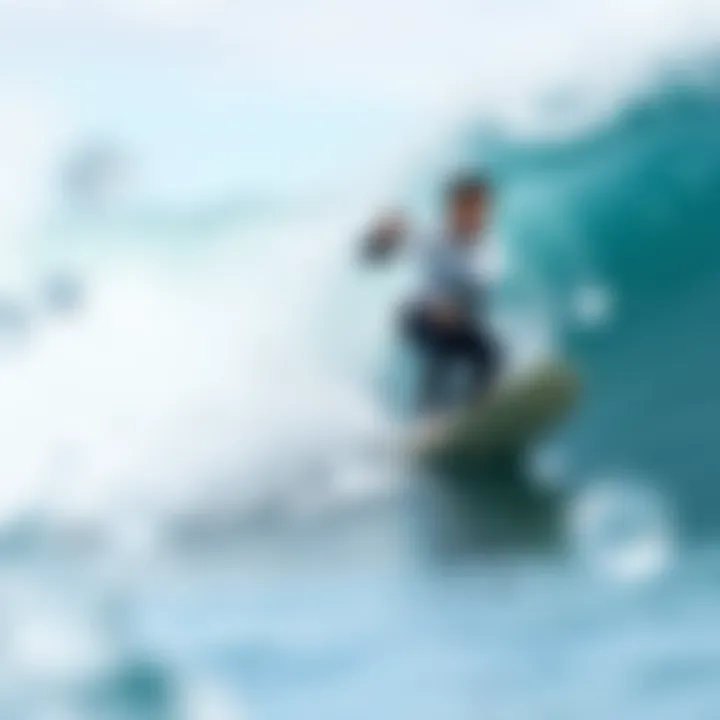
Understanding wind dynamics is essential for anyone looking to elevate their surf experience. It’s not just a matter of waiting for the right waves; it is about adapting to the ever-changing conditions of nature.
In summary, understanding the dynamics of force wind is indispensable for any surfer aspiring to enhance their skills while respecting the ecological balance of their surf environment.
The Physics of Wind Forces
Understanding the physics of wind forces is crucial in comprehending how wind impacts surfing conditions. As surfers ride the waves, they are not just gliding over water; they are engaging in a dynamic interplay between wind elements, wave heights, and their own technique. This section will delve into vital aspects such as wind pressure, its effects on wave mechanics, and methods for measuring wind. By grasping these concepts, surfers can improve their performance and adapt their strategies to varying conditions, achieving a more harmonious connection with the ocean.
Wind Pressure and Its Effects
Wind pressure plays a pivotal role in shaping the surfing experience. Simply put, this pressure refers to the force exerted by the wind on the surface of the water, which can significantly influence wave formation. When wind blows across the water, it exerts friction, creating ripples that develop into larger waves. The relationship between the wind's speed and the height of the generated waves is often linear, meaning that higher wind speeds can lead to more substantial waves.
- Higher Wind Speeds: When it comes to surfing, stronger gusts can produce choppier conditions, making it essential for surfers to adjust their techniques. They might need to brace themselves against sudden shifts or learn how to maneuver through the white water more effectively.
- Pressure Variability: Changing weather patterns can introduce variability in wind pressure. This fluctuation may affect not just the waves' height but also their shape, creating peaks that can be ideal for cutting a clean line. Surfers must be in tune with these changes.
The understanding of wind pressure isn't just theoretical; it's lived on the waves. Surfers keenly observe the winds’ characteristics as they dictate their approach, whether it involves waiting for the perfect set or tackling the fierce chop.
How Wind Affects Wave Mechanics
The mechanics of waves are intricately linked to wind patterns. Waves arise from the transfer of energy from wind to the surface of the water. The angle at which the wind strikes the water surface is crucial.
- Onshore Winds: These winds come from the sea towards the land. They often create steeper waves, which can result in thrilling rides for surfers looking for powerful peaks but also necessitate advanced techniques to navigate them.
- Offshore Winds: In contrast, offshore winds blow from land to sea. They help to clean up the wave face, making them more defined and ideal for surfing. In these conditions, a surfer can find a taut face, conducive to longer rides and more technical maneuvers.
In both scenarios, the nuances of how the wind interacts with water create a canvas that surfers must learn to read. It’s not just about riding the wave but interpreting how the wind shapes the ride itself.
Measuring Wind Speed and Direction
To harness the full advantage of wind forces, surfers must be equipped with knowledge regarding wind speed and direction. Various tools and techniques can help surfers make informed decisions about when and where to surf.
- Anemometers: These devices measure wind speed and are typically portable, allowing surfers to assess conditions at the beach. Understanding the wind speed can indicate whether the waves will be manageable or challenging.
- Wind Maps and Forecasts: Websites and apps provide real-time wind data. By examining these resources, surfers can choose their surf times wisely.
- Local Knowledge: Experienced surfers often rely on their understanding of local wind patterns, gleaned from years spent at specific surf spots. This experiential knowledge can oftentimes be more reliable than technical data alone.
- Example resources include NOAA (National Oceanic and Atmospheric Administration) and Surfline, which provide ample data on wind conditions and forecasts.
In the world of surfing, understanding the physics behind wind forces isn’t just an academic exercise; it’s about enhancing the way surfers engage with the ocean, optimizing their rides, and ultimately allowing them to better enjoy the sport they love.
"Mastering the interplay of wind, waves, and technique is what transforms a good surf session into an unforgettable one."
By grasping these dynamics, surfers can make thoughtful choices, improving both their performance and enjoyment out on the water.
The Interaction Between Wind and Surf Conditions
When discussing the relationship between wind and surfing, it’s pivotal to grasp how these elements intertwine. Wind does not merely serve as a background force; it actively shapes the surf conditions surfers experience. Understanding this synergy is crucial as it influences everything from the quality of waves to the type of surfing technique required. Whether you are a seasoned rider or someone pondering their first venture into surfing, recognizing how wind affects surf conditions can enhance both safety and performance on the water.
Influence on Wave Height and Shape
The height and shape of a wave are directly influenced by force wind. For instance, when winds blow against the tide, they create steeper and more challenging waves. Conversely, winds that blow in the same direction as the surf tend to produce longer, more slowly-breaking waves. This variability becomes critical for surfers aiming to catch the best waves.
"A good surfer knows that it’s not just about riding the wave, but riding the right wave at the right time."
Imagine that you are at a popular beach known for its sharp peaks when a storm approaches. Those strong, brisk winds can stir up the waves, resulting in desirable high peaks. In contrast, gentle breezes might create smaller swells that are easier to ride but less thrilling for those seeking adrenaline. Hence, understanding whether the wind is favorable or unfavorable can dictate not only the height and shape of the waves but also the overall surfing experience.
Role of Offshore and Onshore Winds
Wind direction plays a crucial role in determining wave conditions. Offshore winds, which blow from the land out to sea, are often celebrated by surfers. They can help maintain a clean wave face, allowing for smoother rides and more defined shapes. These winds prevent the surface chop that can hinder performance and affect the surfer’s ability to ride the wave effectively.
On the other hand, onshore winds, blowing from the sea towards the beach, can create a choppy water surface and affect the wave’s quality. Surfers may find themselves struggling against more unpredictable conditions, making it an uphill battle to maintain control while riding.
Here’s a quick breakdown of the two types of winds:
- Offshore Winds:
- Onshore Winds:
- Enhance wave shape
- Reduce surface chop
- Favorable for long rides and advanced maneuvers
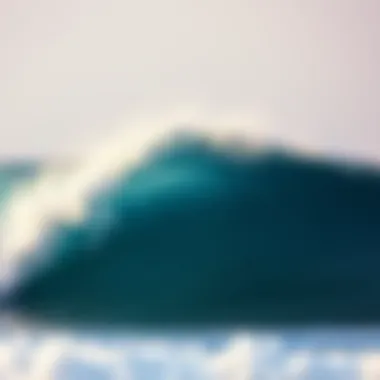
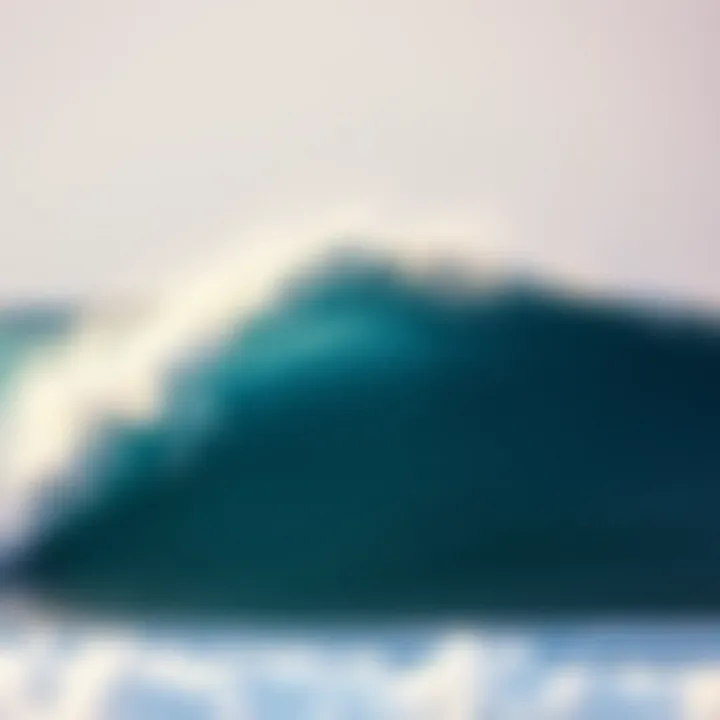
- Create choppy surface conditions
- Can make waves less predictable
- Generally less favorable for performance surfing
Understanding Wind Swells
Wind swells differ from ground swells, leading to varied surfing conditions. Wind swells are generated by local winds, impacting the immediate area, while ground swells travel long distances across the ocean. The latter often results in more powerful and organized waves, whereas wind swells tend to be faster and shorter.
Surfers aiming for optimal conditions need to pay attention to the type of swell they are surfing. Wind swells can provide thrilling rides, but one must time their entry perfectly, often requiring agility and quick reflexes. Considering how long the wind has been blowing and its strength can help surfers decide whether to paddle out for a session.
In summary, understanding wind swells is essential for surfers looking to catch the right waves. Close attention to environmental cues can make the difference between an exhilarating ride and a frustrating morning out on the water.
Wind Patterns and Surf Spot Selection
Understanding how wind patterns impact surf spots is crucial for any surfer aiming to catch the best waves. The interplay between wind conditions and wave dynamics can significantly enhance or diminish the surfing experience. Choosing a surf spot isn't just a matter of convenience. Surfers need to consider wind direction, speed, and persistence to maximize their time on the water.
Identifying Ideal Wind Conditions for Surfing
When it comes to finding the perfect wave, the wind plays a starring role. There are ideal wind conditions that can help transform a mediocre surf session into an unforgettable ride. Offshore winds, which blow from the land toward the sea, are generally considered the best for surfing. They help groom the waves, creating clean faces perfect for riding. In contrast, onshore winds can create messy conditions, causing waves to become choppy and unpredictable.
To identify the ideal wind conditions, surfers should pay attention to:
- Wind Direction: Offshore is best, but also consider side-shore winds for certain breaks.
- Wind Speed: Generally, winds between 5 to 15 mph are ideal; anything stronger can lead to chaotic surf.
- Time of Day: Winds can shift throughout the day, so early morning or late afternoon often presents calmer conditions.
An essential tool in a surfer’s pocket is a wind and tide app or website. Understanding local patterns can help one predict when conditions will align.
Local Wind Effects at Popular Surf Locations
Every surf spot has its own unique wind signature, influenced by local geography and climate. For instance, the renowned Pipeline in Hawaii thrives under certain northeast trade winds, which form perfect barrels. Conversely, Kalahari’s surf can turn unforgivingly rough when south winds hit the coastline.
Here are some notable considerations about local wind effects:
- Geographical Barriers: Mountains or cliffs can redirect winds, creating micro-climates that enhance wave quality.
- Seasonal Changes: Wind patterns shift with seasons. For example, summer may produce lighter breezes conducive for long rides.
- Local Experience: Engaging with local surfers can provide insights into lesser-known winds that can lead to great surf conditions.
"Understanding wind behavior isn't just helpful; it's essential for anyone serious about surfing. Knowing when and where to be out there can mean the difference between a drifty session and an epic one."
The relationship between wind patterns and surf spots is complex but profoundly influential. If surfers take the time to learn and adapt to local conditions, they can vastly improve their surfing performance and enjoyment.
Surfing Techniques in Different Wind Conditions
When it comes to the thrilling world of surfing, understanding how to adapt your techniques based on varying wind conditions can make or break your session on the water. Wind doesn’t just sway the palm trees; it can dramatically influence wave shapes and your overall ride. By honing skills in different wind scenarios, surfers gain substantial advantages in both performance and safety. Here’s a closer look at how to navigate this crucial component of surfing.
Adapting Surfing Style Based on Wind
Adjusting your surfing style based on wind conditions is akin to a musician tuning their instrument before a concert. Each nuance of the wind impacts both wave formation and board control. Not all winds are created equal.
- Onshore Winds: These winds blow from the sea toward the shore, flattening waves and creating choppy conditions. In such instances, surfers should focus on quick turns and maintaining a low center of gravity to stabilize their ride. Quick maneuvers, such as carving and snapping off the top, become essential.
- Offshore Winds: Conversely, when winds blow from land to sea, they can create clean, well-formed waves. Surfers should take advantage of these conditions by embracing longer, more fluid lines and allowing the wave’s natural shape to guide their movements. Grabbing the rail during high-speed turns can enhance control, ensuring a smoother ride down the line.
In all wind conditions, listening to your body and the board’s responses is crucial. Each surfer has a unique skill set, and being attuned to how the wind interacts with your style will yield better results.
Navigating Challenging Wind Scenarios
There are days when Mother Nature decides to spice things up, throwing strong gusts and unpredictable wind patterns your way. These scenarios can test even seasoned surfers. Here are strategies to keep in mind when faced with challenging wind conditions:
- Stay Aware of Wind Changes: Always keep an eye on the horizon. Changes in wind direction or intensity can happen quickly. If you notice flags on the beach whipping about, it’s time to adjust or consider heading in for a break.
- Board Selection: Using the right surfboard can help tackle tricky winds. Shorter boards offer greater maneuverability in quickly changing conditions, while longer boards can stabilize you in turbulent waters. Knowing which board matches specific wind conditions can be a game-changer.
- Partner with Nature: Understanding the local wind patterns can put you one step ahead. Some days may favor a specific spot due to wind direction. Researching local break patterns in advance can help ensure you’re at the right place at the right time.
Additionally, engaging with other surfers can yield invaluable insight. Many experienced locals have a wealth of knowledge about navigating difficult wind conditions—don’t hesitate to share tips and tricks that could help improve your game.
"In surfing, the strongest force may well be the wind, not just the waves. Adjusting to it requires skill, patience, and a willingness to learn from every ride."
By developing a keen understanding of how to tweak your techniques in response to wind, you not only enhance your capabilities but also foster a deeper respect for the complexities of the ocean. Join communities on platforms like reddit.com to further gather knowledge on effective strategies from other surfers who share similar passions.
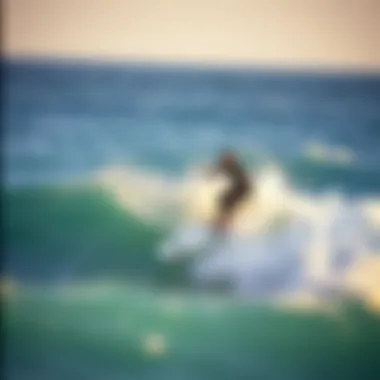
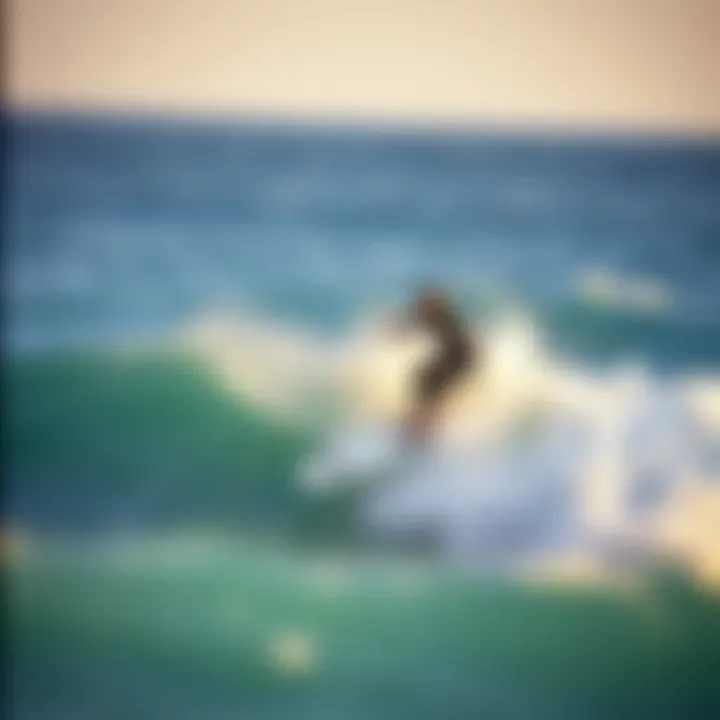
Environmental Considerations
The topic of Environmental Considerations plays a crucial role in understanding how wind dynamics affect the surfing ecosystem. Surfers often focus on the thrill of riding waves, but the interrelationship between wind patterns and the marine environment is a compelling issue that deserves attention. The surfing experience can be significantly influenced by environmental factors, from water quality to wave formation. This section dives into the integral aspects of wind on the surf ecosystem and the lasting consequences these patterns might have on both local environments and the sport itself.
Impact of Wind Patterns on Surf Ecosystem
Wind patterns influence various elements of the surf environment, affecting aquatic life, water quality, and the physical characteristics of waves. Changing wind patterns can lead to different ocean currents, which in turn impact the distribution of nutrients and marine species.
- Nutrient Distribution: Wind generates surface currents that help circulate nutrients through the water, promoting healthy ecosystems. Without adequate wind, nutrient-rich waters might stagnate, noticeable in areas with limited wave action where surf conditions suffer.
- Water Quality: Frequent shifts in wind patterns can influence water clarity and quality. For instance, strong onshore breezes can stir up sediment and contaminants, creating less favorable conditions for both surfers and marine life.
- Marine Habitat: Certain wind conditions are essential for maintaining the balance in local habitats. For example, offshores winds tend to clean up the water, offering clear surf for surfers and a better environment for fish species that thrive in clean environments.
"Surfers should recognize that they are part of a broader ecosystem, and changes in wind patterns are not just about waves; they also reflect the health of ocean life."
Understanding the impact of wind on the ecosystem allows surfers to adopt better practices and encourage conservation efforts. Increased awareness can foster a deeper connection between surfing culture and ecological protection.
Climate Change and its Effects on Wind Dynamics
Climate change has profound effects on global wind patterns, which can disrupt the surfing environment dramatically. Warmer global temperatures are shifting weather systems, impacting local wind behaviors and consequently altering surf conditions.
- Changing Wind Patterns: As climate change progresses, wind patterns may become more erratic. This can lead to unexpected changes in wave size and frequency, challenging surfers’ ability to predict optimal surfing days.
- Increased Storm Frequency: With more frequent and intense storms, coastal areas could face poorer water conditions, making it less pleasurable and safe for surfing. Increased storm activity can create significant swells that may deter many surfers from the water or create hazardous conditions.
- Long-Term Sea Level Rise: Rising sea levels, a direct consequence of climate change, can erode beaches and affect surf breaks. The physiognomy of surf spots, such as reef formations and sandbars, could change forever, impacting the availability of prime locations for surfing.
The relationship between wind dynamics and climate change must be acknowledged, as it highlights the urgency of sustainable practices. Surfers, while striving for the perfect wave, could also become vital advocates for environmental preservation, drawing attention to the need for action amid these changing times.
To delve deeper into the environmental implications of surfing, you may visit additional resources like Wikipedia or Britannica for fundamental insights into ecology and wind effects.
Future of Wind Studies in Surfing
The evolution of surfing does not merely rest on the shoulders of the latest board design or a unique surfing trick. A crucial but often overlooked aspect involves the dynamics of force wind. This section delves into how ongoing studies in wind dynamics can shape the future of surfing, focusing on technological advancements and avenues for further research.
Technological Advances in Wind Measurement
As technology continues to evolve, the tools available for measuring wind conditions have become more sophisticated. Today’s surfers benefit from devices that not only monitor wind speed but also capture minute fluctuations in wind patterns.
For example, handheld anemometers have flourished in popularity. These pocket-sized gadgets enable surfers to assess real-time wind conditions on the beach or out at sea, offering insights that can influence decision-making about when and where to surf. Moreover, sophisticated weather apps leverage data derived from satellite imagery and predictive algorithms to give reliable forecasts on wind conditions, heightening the chances of catching a memorable wave.
In surfing schools and clubs, using emerging technologies like drones has proven essential. Not only can they film surfers in action, but they can also measure wind speed and direction from heights that surpass traditional ground measurement methods. It enhances the understanding of wind interplay with waves in various conditions, paving the way for more informed surfing experiences.
Research Opportunities in Wind-Surf Interactions
The relationship between wind and surf remains a complex interplay that demands further academic exploration. With the sport growing in popularity, there exists a plethora of research opportunities to study this dynamic in depth.
- Wave Formation: Future studies could explore how different wind conditions contribute to wave formation. A deeper understanding of this will have vast implications not just for surfers, but also for surf forecasting.
- Environmental Impact Assessment: Research could examine how climate change alters wind patterns and consequently affects surf ecosystems.
- Material Science in Surfboard Design: Innovative studies into how surfboards react under diverse wind conditions will aid in developing better, more adaptive surfboards.
- Surfer Behavior Adaptation: Social scientists could investigate how surfers change their approach based on forecasts and wind reports. Such studies could enhance community strategies and environmental sustainability in coastal areas.
End
In synthesizing the complex and rich interplay between wind dynamics and surfing, this article underscores a vital aspect of the surfing experience that is often taken for granted. Understanding force wind is not merely about grasping the technicalities; it’s about enhancing performance, safety, and enjoyment in the water. Wind influences everything from the size and shape of the waves to a surfer's ability to ride them effectively. Surfers, whether seasoned or novices, need to align their techniques with the behavior of wind to truly harness what nature offers.
Synthesizing Wind and Surf Knowledge
Integrating knowledge of wind dynamics into surfing practice allows enthusiasts to make informed decisions about when and where to surf. This isn’t just theoretical; it can impact a surfer's performance on a fundamental level. When a surfer recognizes how offshore or onshore winds alter wave quality, they can choose conditions that better match their skills. This synergy between knowledge and practice enriches the surfing experience, ultimately leading to more successful rides and safer outings.
- Key Takeaways:
- Wave Mechanics: Understanding how wind shapes waves can guide surfers in their choice of conditions.
- Technique Adaptation: Applying knowledge of wind conditions allows surfers to modify their approach, enhancing their agility in varying situations.
- Informed Decision-Making: This synthesis equips surfers with the tools to select the best surf spots based on wind analysis.
In this sense, the relationship between wind and surf becomes a dance of sorts, where knowing your partner's moves can mean the difference between an exhilarating ride and a bumpy tumble.
Encouraging Responsible Surf Practices
Riding the waves comes with a responsibility to both the environment and the surfing community. As surfers become more attuned to the nuances of wind and water dynamics, they also need to be conscious of how their actions impact marine ecosystems. This is more than just a personal etiquette; it's a collective effort to keep surfing sustainable.
- Proactive Strategies for Environmental Stewardship:
- Avoid Surfing During Harmful Conditions: Knowing when wind patterns create dangerous surf protects both surfers and the environment.
- Picking Up After Yourself: Ensuring that the beach remains clean preserves natural habitats and maintains the quality of surf spots.
- Educating Others: Sharing knowledge about wind dynamics and environmental impact fosters a culture of consciousness within the surfing community.
As this article illustrates, the connection between surfing and environmental stewardship is undeniable. Surfers must embrace their role as caretakers of the ocean. In doing so, the future of both the sport and the ocean environment remain bright, allowing new generations to enjoy riding the waves in harmony with nature.
"The beauty of surfing is not just in riding the wave but in respecting the forces that create it."















